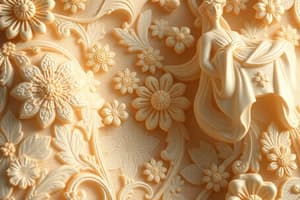Podcast
Questions and Answers
What is a characteristic property of ceramics?
What is a characteristic property of ceramics?
- Soft and malleable structure
- Resistance to chemicals (correct)
- High electrical conductivity
- High thermal expansion
Which type of ceramic is primarily used for making fine china?
Which type of ceramic is primarily used for making fine china?
- Stoneware
- Porcelain (correct)
- Earthenware
- Alumina
Which advanced ceramic is commonly used in biomedical implants due to its hardness?
Which advanced ceramic is commonly used in biomedical implants due to its hardness?
- Silicon Nitride
- Silicon Carbide
- Glass
- Alumina (correct)
What is a typical use of silicon carbide in industrial applications?
What is a typical use of silicon carbide in industrial applications?
Which of the following materials is classified as a hydraulic ceramic?
Which of the following materials is classified as a hydraulic ceramic?
What type of ceramics are known for being used in grinding and polishing applications?
What type of ceramics are known for being used in grinding and polishing applications?
Which traditional ceramic type is relatively low-temperature and porous?
Which traditional ceramic type is relatively low-temperature and porous?
What property makes silicon nitride suitable for use in bearings?
What property makes silicon nitride suitable for use in bearings?
What is a key use of refractory ceramics?
What is a key use of refractory ceramics?
Which type of ceramic is characterized by being non-crystalline?
Which type of ceramic is characterized by being non-crystalline?
Alumina is used in spark plugs due to its high hardness and wear resistance.
Alumina is used in spark plugs due to its high hardness and wear resistance.
Porcelain is known for its strength and is primarily used for structural applications.
Porcelain is known for its strength and is primarily used for structural applications.
Silicon Carbide is primarily used in applications that require excellent thermal shock resistance.
Silicon Carbide is primarily used in applications that require excellent thermal shock resistance.
Cement is classified as a non-hydraulic ceramic.
Cement is classified as a non-hydraulic ceramic.
Stoneware is a porous ceramic primarily used for making decorative figurines.
Stoneware is a porous ceramic primarily used for making decorative figurines.
Refractories are ceramics that can withstand very high temperatures.
Refractories are ceramics that can withstand very high temperatures.
Glass is considered a crystalline ceramic used for making optical fibers.
Glass is considered a crystalline ceramic used for making optical fibers.
Abrasives include hard ceramics used for functions like grinding and polishing.
Abrasives include hard ceramics used for functions like grinding and polishing.
Earthenware is a high-temperature ceramic primarily used for making decorative tiles.
Earthenware is a high-temperature ceramic primarily used for making decorative tiles.
Silicon Nitride is utilized in engine components due to its high strength.
Silicon Nitride is utilized in engine components due to its high strength.
Flashcards are hidden until you start studying
Study Notes
Ceramics Overview
- Non-metallic, inorganic solids created by heating and cooling a starting material.
- Renowned for hardness, high-temperature tolerance, and chemical resistance.
Traditional Ceramics
- Earthenware: Porous, low-temperature ceramic used for pottery, tiles, and bricks.
- Stoneware: Strong, non-porous ceramic used for tableware, cookware, and decorative items.
- Porcelain: High-temperature ceramic known for its translucence and delicacy, used for fine china, figurines, and electrical insulators.
Advanced Ceramics
- Alumina (Al2O3): Used in spark plugs, cutting tools, and biomedical implants due to its high hardness and wear resistance.
- Silicon Carbide (SiC): Used in high-temperature applications like furnace linings and kiln furniture due to its excellent thermal shock resistance.
- Silicon Nitride (Si3N4): Used in engine components, bearings, and cutting tools due to its high strength and wear resistance.
Other Ceramic Types
- Glass: Non-crystalline ceramic used for windows, bottles, and optical fibers.
- Cement: Hydraulic ceramic used as a binder in concrete and mortar.
- Refractories: Ceramics that can withstand very high temperatures, used in furnaces, kilns, and crucibles.
- Abrasives: Hard ceramics used for grinding, cutting, and polishing, such as sandpaper and grinding wheels.
Ceramics
- Non-metallic, inorganic solids
- Created by heating and cooling materials
- Known for hardness, high-temperature resistance and chemical resistance
Traditional Ceramics
- Earthenware:
- Porous, low-temperature ceramic
- Used for pottery, tiles, and bricks
- Stoneware:
- Strong, non-porous ceramic
- Used for tableware, cookware, and decorative items
- Porcelain:
- High-temperature ceramic
- Known for translucence and delicacy
- Used for fine china, figurines, and electrical insulators
Advanced Ceramics
- Alumina (Al2O3):
- High hardness and wear resistance
- Used in spark plugs, cutting tools, and biomedical implants
- Silicon Carbide (SiC):
- Used in high-temperature applications
- Excellent thermal shock resistance
- Used for furnace linings and kiln furniture
- Silicon Nitride (Si3N4):
- High strength and wear resistance
- Used in engine components, bearings, and cutting tools
Other Ceramics
- Glass:
- Non-crystalline ceramic
- Used for windows, bottles, and optical fibers
- Cement:
- Hydraulic ceramic
- Used as a binder in concrete and mortar
- Refractories:
- High-temperature resistant ceramics
- Used in furnaces, kilns, and crucibles
- Abrasives:
- Hard ceramics used for grinding, cutting, and polishing
- Examples are sandpaper and grinding wheels
Studying That Suits You
Use AI to generate personalized quizzes and flashcards to suit your learning preferences.




